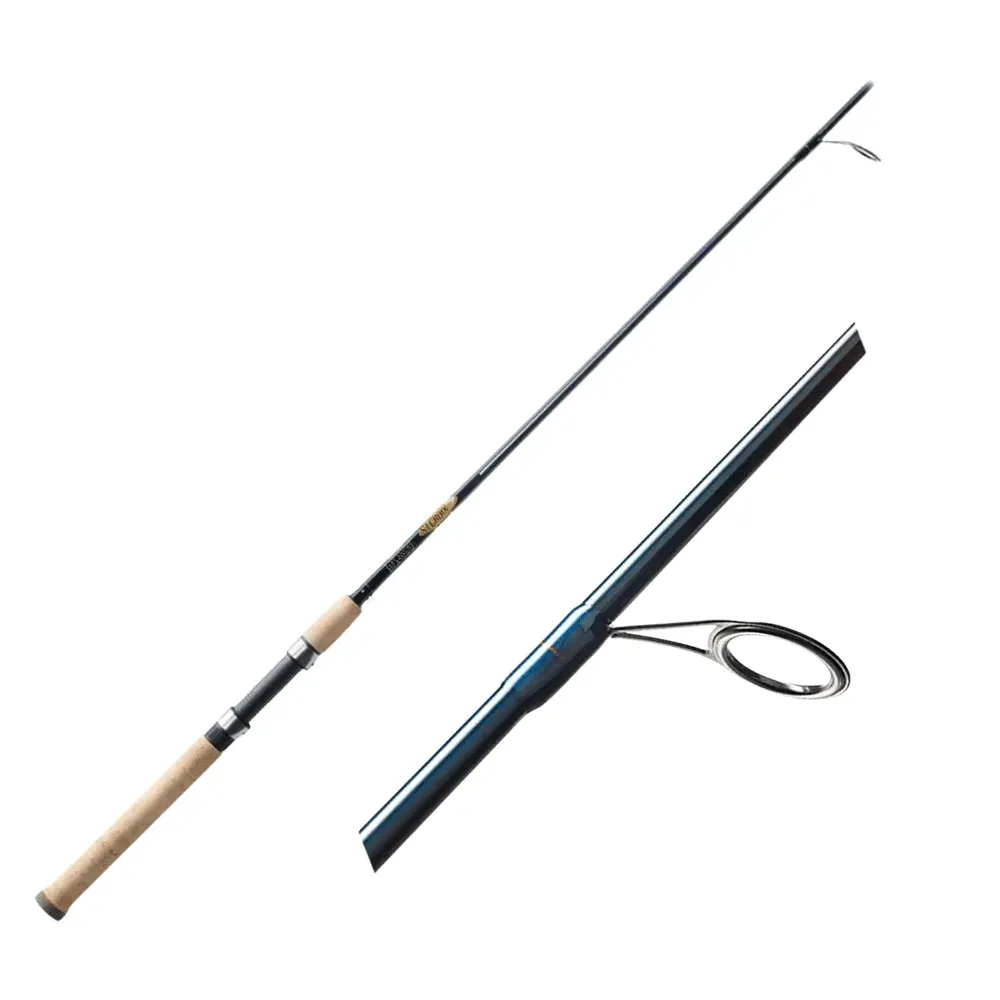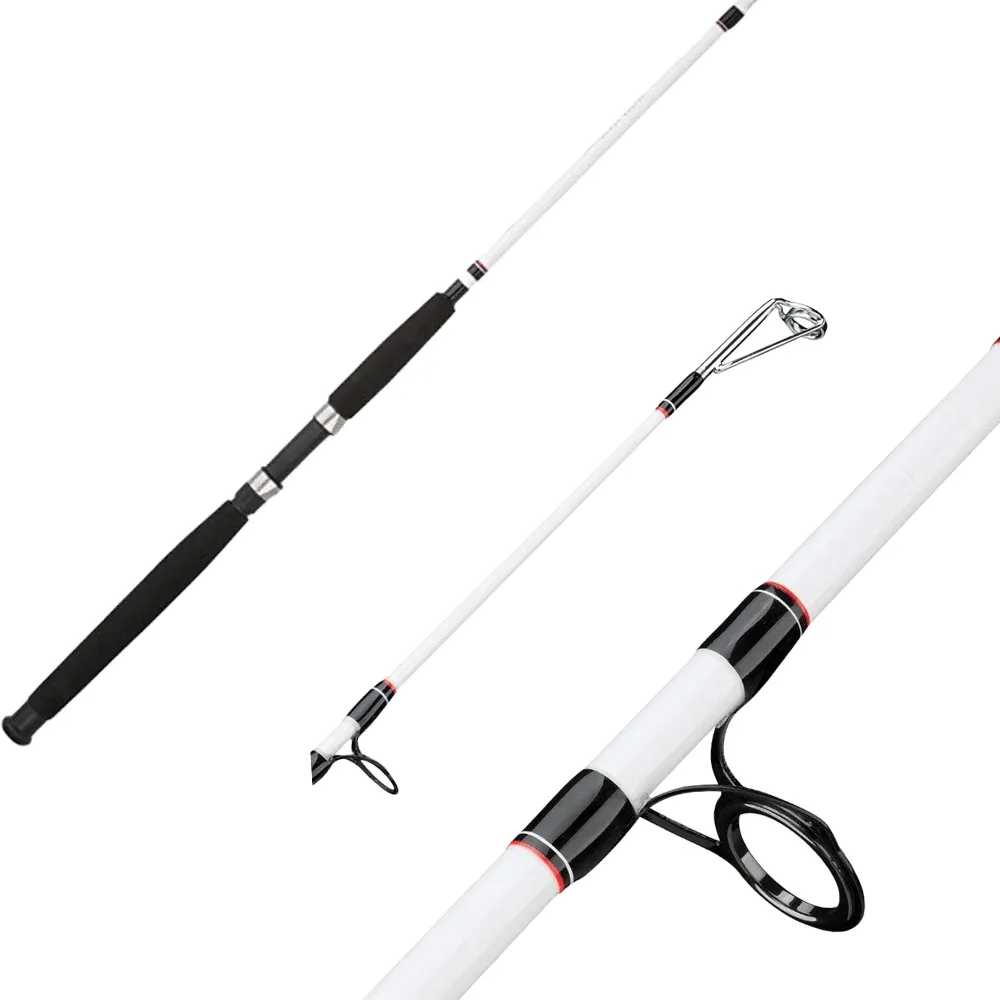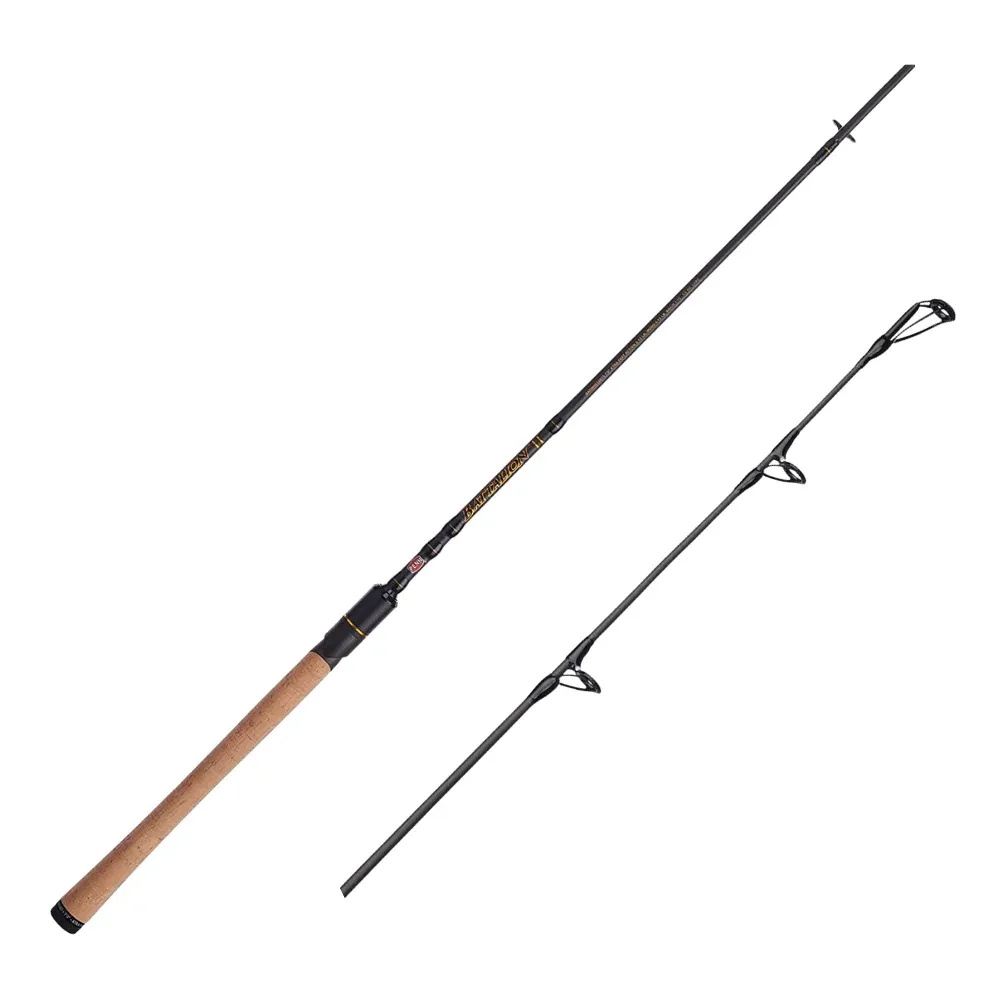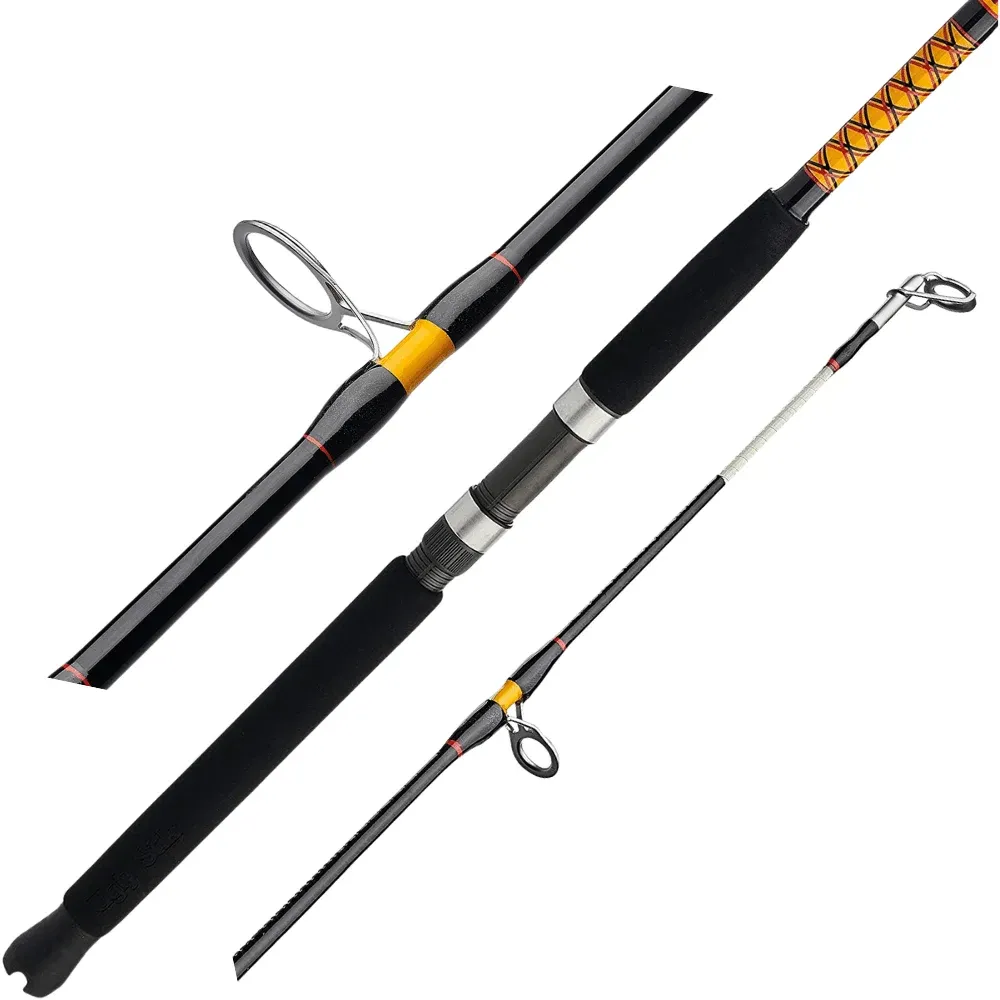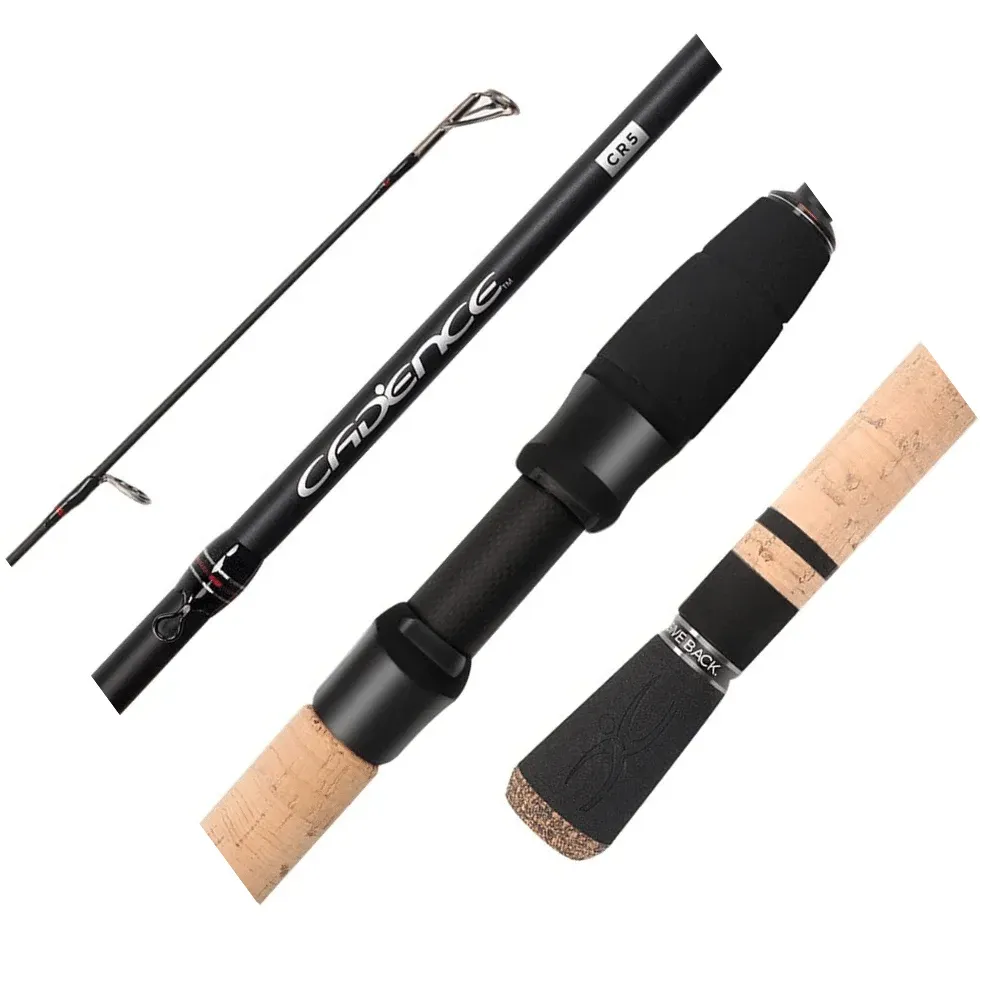Ready to go saltwater fishing?
We’ve got you covered with the best saltwater fishing rods on the market. Check out our buyer’s guide to find the perfect rod for your needs, and then read on for our top 10 recommendations.
With the right rod in your hand, you can catch fish of all sizes in any saltwater environment. So don’t wait – get ready to reel in that big one!

How We Choose The Best Saltwater Fishing Rods
If you're looking for a saltwater fishing rod, there are a lot of things to consider. You want to find the best rod for your needs, but it can be hard to know where to start.
There are so many different saltwater fishing rods on the market that it can be hard to know which one is right for you. Do you go with a casting reel or a spinning reel? What size should your rod be? How much should you spend?
I've done all the hard work for you and have compiled this list of the best saltwater fishing rods based on my findings. I've only included saltwater spinning rods in this article because they are more versatile and easier to master than rods with casting reels.
Why It’s On Our Best List
When you pick up a St. Croix Rods Triumph Spinning Rod you'll immediately notice how light and well-balanced it feels in your hand. That's because every detail of these rods has been designed for ultimate performance and sensitivity.
Whether you're fishing for bass, trout, or snapper, you'll be able to feel every little nibble with these rods. They're also built to be incredibly durable, so you can enjoy them for years to come. If you're serious about fishing, then you need a St. Croix Triumph Spinning Rod.
Highlights
St. Croix Rods Triumph Spinning Rods are designed with the angler in mind. The premium SCIII carbon rod provides the strength and sensitivity needed to land the big one, while the contoured, premium-grade cork handle ensures a comfortable grip. The Sea Guide Atlas Performance SS304 guides are corrosion-resistant and provide smooth consistent casting, and the Sea Guide XDPS reel seat provides a solid foundation for your reel.
The two coats of Flex-Coat slow-cure finish protect the rod from wear and tear, and the St. Croix 5-year warranty guarantees that this rod will provide years of trouble-free fishing. So whether you're chasing striped bass or red snapper, you can trust St. Croix Rods to deliver unbeatable performance.
4.5/5 - 612 ratings - 95 verified purchase reviews
Why It’s On Our Best List
The Berkley Big Game Spinning Fishing Rod is a great choice for anglers on a budget. For the price, this rod is a beast! You can easily cast a 4-ounce weight with 2 baited hooks. It's also very durable, making it great for fishing from the shore or from a pier. This rod casts well and is sensitive enough to feel strikes, making it a great choice for serious anglers.
This rod is sure to give you a great day out on the water.
Highlights
Berkley Big Game spinning fishing rod features an X-veil high modulus blank construction for increased strength and sensitivity. Fenwick custom ergonomic reel seat ensures a comfortable grip for all-day fishing. Titanium guides with slim profile zirconium inserts are durable and provide smooth casts. EVA and TAC split grip handle provides added comfort and extends your fight against big fish.
The limited lifetime warranty gives you peace of mind when purchasing this Berkley spinning rod. Berkley definitely has your back when it comes to big-game fishing. They have thought of everything from the X-veil high modulus blank, to the titanium guides with slim profile zirconium inserts, providing you with a durable and sensitive fishing rod. So go out and fight the big fish with Berkley Big Game spinning fishing rod!
4.6/5 - 1513 ratings - 201 verified purchase reviews
Why It’s On Our Best List
Looking for a versatile, durable, and sensitive spinning rod? Look no further than the Penn Battalion Inshore Spinning Rod. This pole is perfect for fishing in both fresh and saltwater and can handle large fish with ease. The flexible but sturdy blank provides excellent sensitivity, so you can feel even the smallest bite. But don't worry - there's plenty of backbone for hauling in big fish when you need to.
The Penn Battalion Inshore Spinning Rod is the perfect choice for serious anglers who demand the best.
Highlights
The Penn Battalion Inshore Spinning Rod is designed for optimum performance in inshore fishing conditions. It features SLC2 construction for increased strength and sensitivity, Fuji Alconite guides for superior durability, and Fuji reel seats for a secure connection to your reel. The Penn Battalion also features premium cork grips, and rubber shrink tube handles on select models, providing a comfortable and secure grip even when wet.
Whether you're targeting redfish, snook, or trout, the Penn Battalion Inshore Spinning Rod has the power and performance you need to land the big one.
4.5/5 - 196 ratings - 44 verified purchase reviews
Why It’s On Our Best List
The Ugly Stik Bigwater Spinning Fishing Rod is the perfect choice for anglers who demand the very best. The saltwater cousin to the fantastic Ugly Stik GX2, this tough yet sensitive rod is built to withstand the rigors of surf fishing, and its powerful build ensures that you'll be able to cast your line far out into the water. The Bigwater is hefty without being excessively heavy, making it easy to handle for long periods of time.
And thanks to its durability, you can be sure that this rod will last for many seasons to come. With the Bigwater, you'll be able to land anything from bluefish to big sharks! So don't wait any longer - get your hands on the Ugly Stik Bigwater Spinning Fishing Rod and see for yourself why it's such an excellent rod!
Highlights
The Ugly Stik Bigwater Spinning Fishing Rod is perfect for anglers who want a durable and reliable rod that can handle big fish. The Ugly Tech construction with a combination of graphite and fiberglass makes this rod virtually indestructible, and the Ugly Stik Clear Tip provides sensitive feedback so you can feel even the lightest bites. The Ugly Tuff Guides are also built to last, eliminating insert pop-outs so you can focus on fighting the fish, not your gear.
And for added comfort, this rod features a Fuji Reel Seat and a durable rubber gimbal on select models. Whether you're an experienced angler or just getting started, the Ugly Stik Bigwater Spinning Fishing Rod is a great choice for anyone who wants a high-quality, dependable fishing rod.
4.7/5 - 879 ratings - 156 verified purchase reviews
Why It’s On Our Best List
The Cadence Spinning Rod is the perfect choice for anglers who are looking for a high-quality, sensitive rod. With its fast tip and strong backbone, the Cadence Spinning Rod allows you to feel even the lightest nibbles from fish, giving you the opportunity to set the hook and reel them in.
The Cadence Spinning Rod is also light enough to cast all day long without feeling weighed down, yet it's also strong enough to pull in big fish. So whether you're an experienced angler or just starting out, the Cadence Spinning Rod is a great choice for anyone who wants a great feel and touch while fishing.
Highlights
Cadence Spinning Rods are designed with the serious angler in mind. With a focus on quality and performance, Cadence rods are built to withstand the rigors of saltwater fishing. The Cadence Spinning Rod is constructed with an ultra-high quality 30-ton carbon fiber blank and features stainless steel guides with SiC inserts.
The cork handle provides comfort and grip, while the Fuji reel seat ensures a secure connection between reel and rod. Whether you're targeting bass, trout, or saltwater species, the Cadence Spinning Rod has the power and sensitivity to help you land that trophy fish.
4.4/5 - 1616 ratings - 563 verified purchase reviews
Best Saltwater Fishing Rods FAQs

Buying a saltwater fishing rod can be intimidating, especially if you're new to the sport.
There are a lot of factors to consider when buying a saltwater fishing rod- from the type of fishing you plan on doing, to the size and weight of the fish you hope to catch.
We're here to help. We've compiled the most frequently asked questions about saltwater fishing rods so that you can make an informed decision today.
What is a good fishing rod for saltwater fishing?
A good fishing rod for saltwater fishing is a medium-heavy action rod. It should be at least 9 feet long to give you the leverage you need to fight big fish. And it should have a fast taper so that it can load up quickly and give you the power to make long casts.
How do I choose a saltwater rod?
When choosing a saltwater rod, it's important to consider the weight and action of the rod. Heavier rods are better for casting larger baits in stronger currents, while lighter rods are more suited for smaller baits in calmer waters.
Action describes how much the rod bends when you apply pressure. Fast-action rods flex near the tip, while slow-action rods bend more gradually toward the handle. Most saltwater fish require a heavy-action rod to fight against strong currents and keep them on the line. However, if you're targeting smaller fish or fishing in calm waters, a light-action rod will work better.
What makes a rod good for saltwater?
There are a few factors to consider when choosing a rod for saltwater fishing. One of the most important is the strength of the rod. A good saltwater rod needs to be able to handle the stress of fighting big fish in tough conditions. It's also important to choose a rod that is resistant to corrosion.
Another factor to consider is the type of reel that will be used with the rod. There are several different types of reels that can be used for saltwater fishing, and each one has its own strengths and weaknesses. Some anglers prefer spinning reels for saltwater fishing, while others prefer baitcasting reels.
Finally, it's important to match the size of the rod with the size of the fish you plan on catching. A larger, heavier rod is necessary for fighting bigger fish, while a smaller, lighter rod will work better for targeting smaller fish.
What is the best rod for beach fishing?
There is no one-size-fits-all answer to this question, as the best rod for beach fishing will vary depending on the specific type of fishing you plan to do. However, a good general rule of thumb is to use a medium-heavy or heavy rod with moderate action for beach fishing. This will allow you to cast larger lures and bait farther out into the surf, and will also give you enough power to fight bigger fish.
What size reel is best for saltwater fishing?
It depends on the type of fishing you are doing. For example, if you are trout fishing in a small stream, then you would use a smaller reel than if you were fishing for sharks in the ocean.
That being said, here are some general guidelines: For bottom-fishing or casting from the shore, a reel with a line capacity of 125 yards of 12-pound test monofilament is a good choice. If you're targeting larger fish such as redfish or seatrout, go with a reel that has at least 200 yards of 20-pound test line. And for offshore species such as tuna or marlin, consider something with even more line capacity—500 yards or more of 50-pound test
Is a medium heavy rod good for saltwater fishing?
It depends on the species of fish you are trying to catch.
A medium heavy rod is good for larger saltwater fish, such as tuna, sailfish, and marlin. For smaller saltwater fish, you would want a lighter rod. A good rule of thumb is to use a heavier rod when casting farther out into the water and use a lighter rod when fishing closer to shore.
How many inshore rods do you need?
You'll need at least one inshore rod if you plan on fishing in saltwater. Inshore rods are designed to cast light lures and baits in areas near the shoreline, such as sandbars, docks, and mangroves. They're also perfect for targeting smaller fish like speckled trout, redfish, flounder, and catfish.
How do you match a saltwater rod and reel?
It's best to match the weight of your reel to the weight of your rod. So if you have a light rod, you'll want a light reel, and vice versa.
When it comes to saltwater fishing, it's also important to choose a reel that's corrosion-resistant. Many reels are made from anodized aluminum, which is ideal because it won't corrode in saltwater.
Another factor to consider is the size of the reel. If you're fishing for smaller fish, you'll want a smaller reel. And if you're targeting larger fish, you'll need a larger reel with more line capacity.
Last but not least, make sure your reel has good drag that matches the weight of your target fish.
Can you use any rod in saltwater?
Yes, you can use any rod in saltwater. However, it is important to use a rod that is specifically designed for saltwater fishing.
Saltwater can be extremely corrosive and can damage equipment if it is not properly protected. Rods that are specifically designed for saltwater fishing are made with materials that are resistant to corrosion and can withstand the harsh conditions of the ocean.
If you are not sure whether your rod is safe for use in saltwater, it is best to consult the manufacturer or a qualified fishing expert before using it in the ocean.
How much should I spend on a saltwater rod?
It depends on what you want to use the rod for. For example, if you're looking for a surf rod, you'll need something heavier and more expensive than a rod meant for fly fishing in a river.
That said, a good starter rod can be had for as little as $50, while high-end models can cost several hundred dollars. It all depends on your budget and what you're looking to do with it.
Fishing Rods 101: A Beginner’s Guide to Choosing the Right One
If you’re new to fishing, choosing the right fishing rod can be a daunting task.
Don’t worry – we’re here to help! In this article, we will discuss the basics of choosing a fishing rod and provide some tips for beginners.
Fishing can be a fun and exciting hobby, and it’s definitely a great way to get outdoors and enjoy nature. Once you have chosen the right fishing rod and reel combo for you, all that’s left is to get out there and start fishing!
Read on to learn more about choosing a fishing rod.
The Four Most Important Things to Consider
It can be tricky to know where to start when choosing a fishing rod. However, if you consider the four main factors of rod length, material, action, and power, you'll be well on your way to finding the perfect rod for your needs.
Rod length is important because it affects the reach of your casts and the amount of line you can easily manage. Material is another key consideration, as different materials have different weight and strength properties. Action refers to the flexibility of the rod, and affects both casting ability and fish-fighting performance. Finally, power is a measure of the rod's strength and determines what kind of fish you'll be able to target.
By taking all of these factors into account, you can find a fishing rod that's just right for you.
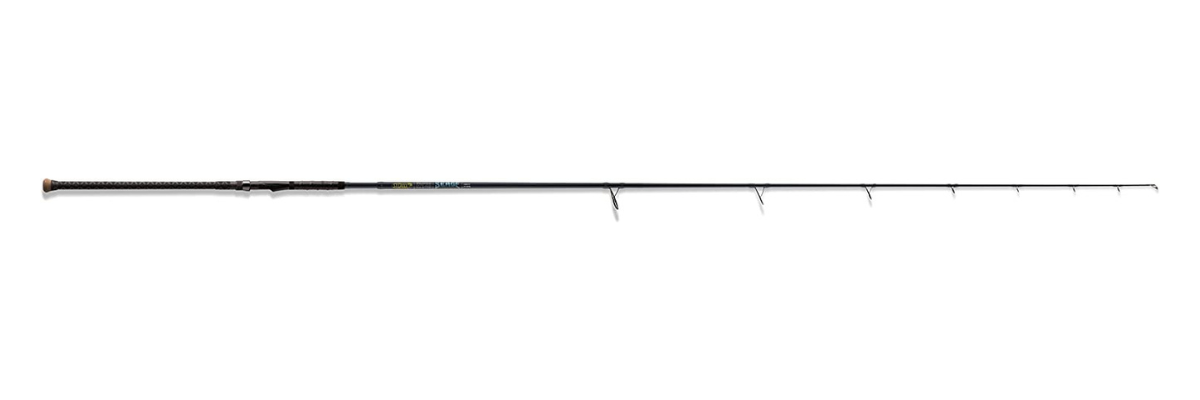
Rod Length
Fishing rods come in a variety of lengths, from short rods designed for casting small lures to long surfcasting rods that can reach out into the waves. The length of the rod you choose will largely depend on the type of fishing you plan to do. For example, if you're planning to fish in a small pond or stream, a shorter rod will be easier to maneuver.
On the other hand, if you're hoping to cast a line out into the open ocean, you'll need a longer rod to give you the distance you need. In general, though, most anglers find that a medium-length rod is the most versatile choice. With a medium-sized rod, you'll be able to fish in a variety of conditions and still have enough power to land large fish.
Rod Materials
Fishing rods are typically made from one of three materials: fiberglass, graphite, or composite. Fiberglass is the heaviest and most durable of the three materials, making it a good choice for beginners or those who fish in heavy cover. It is also the least expensive option. Graphite is lighter and more sensitive than fiberglass, making it a good choice for experienced anglers. Composite rods combine the durability of fiberglass with the sensitivity of graphite, making them a good all-around choice. When choosing a fishing rod, consider the type of fish you will be targeting and the type of water you will be fishing in. Then, select the material that best suits your needs.
Rod Action
When choosing a fishing rod, one of the most important factors to consider is the action. The action of a rod refers to how much bending or flexing occurs when pressure is applied to the tip. There are three main types of actions: fast, medium, and slow. Fast action rods bend mostly in the tip, while medium and slow action rods have a gradual bend that extends further down the length of the blank. Each type of action has its own advantages and disadvantages, so it's important to choose the right one for the type of fishing you'll be doing.
Fast-action rods are great for fish that strike quickly, such as bass and trout, but they can be more difficult to control when casting. Medium and slow action rods are better suited for more gentle fish, like striper, but they can also be used for larger fish that require more power to reel in. No matter what type of fishing you're planning on doing, there's a rod out there with the perfect action for you.
Rod Power
When choosing a fishing rod, one of the most important factors to consider is power. Fishing rods are classified by their power, which is based on the amount of weight they can comfortably handle. For example, a light power rod is designed for smaller fish, while a heavy power rod can handle larger fish. The type of fish you plan on catching will help determine the best power for your needs.
In general, lighter power rods are more versatile and can be used for a variety of different fish, while heavier power rods are better suited for larger fish. When in doubt, it's always best to err on the side of caution and choose a rod with more power than you think you'll need. That way, you'll be prepared for anything.
Fishing Rod Components
A fishing rod is composed of several different parts, each of which serves a specific purpose. The guides are small rings that are attached to the rod. They help to guide the line and keep it from tangling. The handle is the part of the rod that you hold onto when you are casting. It is typically made of foam or cork for a comfortable grip. The rod shape refers to the overall shape of the rod, which can vary depending on the type of fish you are trying to catch. For example, a spinning rod is typically shorter and more flexible than a baitcasting rod. By understanding the function of each component, you can choose the right fishing rod for your needs.
Guides

Line guides are an important part of any fishing rod, and there are a few things to keep in mind when choosing them. First, the material of the guide should be matched to the type of line being used. For example, braided lines work best with ceramic guides, while monofilament lines work best with stainless steel guides. Second, the size of the guide should be appropriate for the line being used. A larger guide is needed for heavier lines, while a smaller guide can be used for lighter lines.
Finally, the number of guides on a rod can vary depending on the type of fishing being done. Generally, spinning rods have fewer guides than casting rods, as the spinning action of the rod helps to keep the line in place. However, there are no hard and fast rules when it comes to choosing line guides, so it is ultimately up to the fisherman to decide what works best for their purposes.
Handle Material
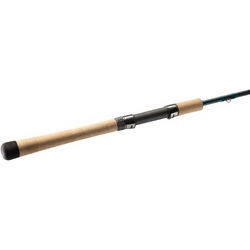
Most handles are made from cork or EVA foam and both have benefits. Cork is generally the most comfortable material and also more expensive. It transfers vibrations better allowing for a better feel on those small nibbles and retains heat from your hands better when fishing on a cold morning. It does dent and chip much easier, though, and is harder to clean. While foam handles perform slightly worse in the above situations, their main benefits are that they are cheaper, easier to maintain, and will last longer.
Spinning Rods vs. Casting Rods
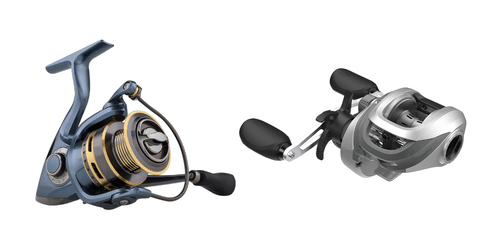
When it comes to fishing, there are two main types of rods: spinning and casting. Each type has its own advantages and disadvantages, so it's important to choose the right one for the job. Spinning rods are typically lighter and more versatile, making them a good choice for smaller fish. They're also easier to use, which makes them a good option for beginners. However, spinning rods can be harder to control in windy conditions and are more likely to tangle line.
Casting rods, on the other hand, are heavier and more powerful, making them better suited for larger fish. They're also more accurate, which is important when fishing in open water. However, casting rods can be difficult to use and require more practice to master. So, which type of rod is right for you? It depends on your skill level and what kind of fish you're hoping to catch.
What's The Writing On a Rod Mean?
We bet you've seen the writing on the rod near the handle.

For example: BSLR802UL Lure 1/32 – 1/4 oz Line 2-6 lb
What does it mean? In this case, the rod numbers indicate that it is a 8-foot, ultra-light, 2-piece rod. It is rated for a 2-6 lb line and works best with 1/32-1/4 ounce lures.
Choosing a Rod
Fishing rods and reels can be confusing to shop for, but with the right information, you can find the perfect one for your needs. In this article, we’ve discussed some of the most important factors to consider when purchasing a fishing rod and reel. We hope that this information has helped you make a decision about which setup is best for you. If you have any questions, don’t hesitate to check out our other articles on fishing rods and reels. Thanks for reading!

The Best Saltwater Fishing Rod For you
So, what is the best saltwater fishing rod to buy? After reading through thousands of user reviews, our team has found the best-rated and most-trusted products that you can buy. Thanks for reading! We hope this article helped you make your purchase decision. Don’t forget to click the button above to check out prices!





